Research - (2022) Volume 10, Issue 1
In vitro Bioactivities of Aqua Alcoholic Extracts of Plant Boerhavia Diffusa Linn.
Naz Fathima Raj Mohamed1, Priyadharshini R1*, S Rajesh Kumar2 and Palati Sinduja1
*Correspondence: Priyadharshini R, Department of Pathology, Saveetha Dental College, Saveetha Institute of Medical and Technical Sciences (SIMATS), Chennai, India, Email:
Abstract
Background: Herbal extract of various plants have been reported to have cytotoxic and antioxidant effects. However, nanoparticle synthesis from these plants requires high resources and technical expertise. There is a need for a cost effective Nano formulation preparation method. Boerhavia diffusa is an herbal plant used for its cytotoxic and antioxidant effects in various diseases. The objective of the present study is to evaluate the in vitro antioxidant and cytotoxic activity from the aqua alcoholic extracts of plant Boerhavia diffusa. Materials and Methods: The current study was a cross-sectional observational analytic study. Our study includes 150 children having the age group of 3 to 12 years who visit the Department of Pediatric Dentistry in the College of Dentistry, King Khalid University. One hundred and fifty children (range 3-12 years) were included whose parents reported snoring on a regular basis and signs or symptoms of OSA. A self-administered questionnaire was prepared in both Arabic and English languages and distributed to all the participants. All the data were collected and analyzed by using SPSS version 21. Materials and Methods: Assessment of antioxidant activity is carried out by in vitro method Diphenyl-1-picryl hydrazyl radical (DPPH) scavenging method and cytotoxic activity live brine shrimp assay by counting the number of live brine shrimps after 24 hours and 48 hours. Values are tabulated and spearman correlation analysis was done in SPSS software version 23. Results: The activity of the aqua alcoholic extract was compared with standard ascorbic acid by measuring absorption intensity in the spectrophotometer at the wavelength of 517 nm. While increasing the concentration of plant extracts the percentage of DPPH inhibition also increased which showed positive correlation(r=1). As a result of the death of numerous nauplii, cytotoxic activity increased, which was measured after 48 hours and it shows negative correlation(r=-1). Conclusion: Boerhavia diffusa have cytotoxic and antioxidant properties. The natural plant based nanoparticles with its phytoconstituents in a single pace adds up a huge advantage in eco-friendly nano research.
Keywords
Boerhavia diffusa, Antioxidant, Cytotoxicity, Aqua alcoholic extract, Innovative technique
Background
Boerhavia diffusa (Punarnava), belongs to the family Nyctaginaceae with forty species. Among these species, Boerhavia diffusa is widely distributed in subtropical and tropical areas of Africa, Asia, America, and Australia [1]. Among all these, Boerhavia diffusa is the most widely studied plant and has many uses in Ayurvedic and Unani medicines [2]. In Ayurveda, this medication is utilized as Sothaghna (Anti-inflammatory), Mootrala (diuretic), Kasahara (Antitussive), Rasayana (rejuvenator), jwarahara (antipyretic) [3]. The root has numerous therapeutic benefits in the treatment of diabetes, inflammation, jaundice, spleen enlargement, stress, dyspepsia, stomach discomfort, heart disease and bacterial infections. Some tribal cultures eat the entire plant of this herb [4,5]. It has also been reported to be effective as an antiviral agent and also for the treatment of elephantiasis, night blindness, corneal ulcers, and various liver disorders [6]. It has been commonly used in Nigerian traditional medicine for treating epilepsy [7] miscarriage, and menstrual pain [8]. The secondary metabolites of Boerhavia diffusa hydroethanolic extract had different medical benefits such as elevated antioxidant activity providing some support for cardiovascular and weight reduction [9]. Chemical components and medicinal activity of Boerhavia diffusa have been extensively researched. Rotenoids, flavonoids, flavonoid glycosides, xanthones, purine nucleoside, lignans, ecdysteroids, and steroids are some of the isoflavones found in the roots.
Various animal studies and trials have confirmed the presence of activities, for example, immunomodulation, hepatoprotection, antifibrinolytic, anticancer activity, antidiabetic activity, anti-inflammation, and diuresis [10,11]. An important indication of BD in traditional medicine is abdominal tumor. Various studies (in vitro and in vivo) suggest the presence of potential anticancer compounds in various extracts prepared from various plant parts. Manu and his colleagues extracted the alkaloid punarnavine from the roots and discovered that it has antimetastatic properties [12]. Similarly, Srivastava and coworkers showed a dose-dependent in vitro cytotoxic effect of the extract of the Boerhavia diffusa root and the leaf in HeLa and U-87 tumor cell lines. Crude ethanolic extract of the root (200μg/mL) and the leaf (300μg/mL) showed 30 and 40% cell death while alkaloidal fraction (300μg/mL) and methotrexate (200 nM) showed 40% cell death [13,14]. Studies showed that Boeravinone, which is also present in Punarnava, also shows antioxidant and cytotoxic activity [12,15]. Rachh and coworkers evaluated ethanolic and methanolic extracts of the dried root powder for antioxidant activity. The extract showed good in vitro antioxidant activities in terms of ferric reduction and hydrogen peroxide quenching in comparison to ascorbic acid [16].
But recent research suggests that antioxidants decrease the risk of chronic diseases including heart disease and cancer [17]. Natural methods like herbal medicines play a vital role in the prevention and treatment of cancer. A significant number of studies on photochemistry, pharmacology have been carried out with no sufficient data available on in vitro activities. Our team has extensive knowledge and research experience that has translated into high quality publications [18-37]. The present study aimed to study the antioxidants and cytotoxic activity of aqua alcoholic extract of B. diffusa.
Materials and Methods
Study setting
The present in vitro study was conducted in the Nano Research lab in Saveetha dental college and hospitals Chennai. The powdered form of Boerhavia diffusa plant extract was readily available in customized form obtained from Botanical supplier’s Chennai. The readymade availability of plant excerpts adds an advantage in minimizing the manual chores and time.
Nanoformulation of plant extract
Fresh dried and powdered readily available Boerhavia diffusa plant material of 1gm is measured in an unbiased manner along with 100ml of distilled water and filtered with Whattman filter paper. 10ml of ethanol is mixed with the clear filtered extract. The (tortilla) colour change is observed. The validation of the procedure is finalized by the principal investigator and senior researchers (Figure 1).
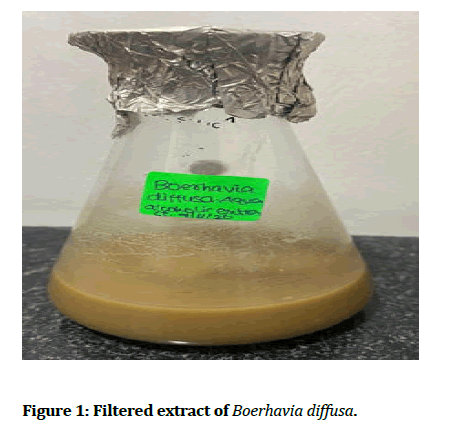
Figure 1: Filtered extract of Boerhavia diffusa.
Reagent and chemicals
DPPH (400 μg/mL),
5 mL of solutions of aqua alcoholic B. diffusa extracts of different concentrations (10 to 50 µg/mL)
Positive control: ascorbic acid, potassium dichromate
Negative control: DMSO: dimethyl sulfoxide
Diphenyl-1-picryl hydrazyl (DPPH) radical scavenging method
The radical scavenging activities of aqua alcoholic extract of Boerhavia diffusa were estimated using stable free radicals of DPPH. About 2.0 mL of methanol solution of each extract at different concentrations (10, 20, 30, 40 and 50 μg/mL) were mixed with 3.0 mL of DPPH methanol solution (20 μg/mL). After an incubation period of 30 min, the absorbance was measured at 517 nm against methanol as blank by using a UV-visible spectrophotometer. The radical scavenging activity (%) was calculated based on the following formula:
% Inhibition=OD of control-OD of test/OD control*100
The percentage scavenging activity of each extract was compared with ascorbic acid, the positive control. IC50 value of each extract was determined from the plotted graph of percentage DPPH neutralization and concentration of extract, which was defined as the amount of antioxidant required to reduce the initial DPPH free radical concentration by 50% (Figure 2).
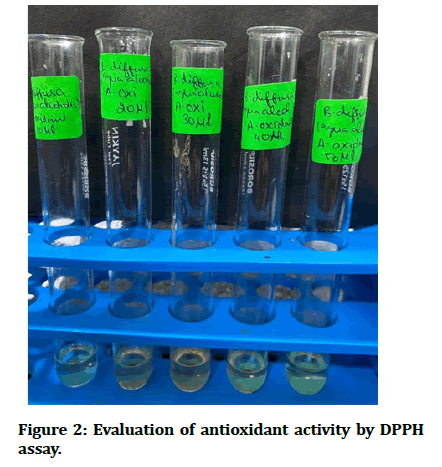
Figure 2: Evaluation of antioxidant activity by DPPH assay.
Cytotoxic activity assayBrine shrimps are zooplankton adult habitats of Nauplii. The amount of lethality of the principle extract solution of Boerhavia diffusa was analysed from the number of live brine shrimp in room temperature at different concentrations (10-50μl) of the prepared bio extract loaded in the microplate. Twelve well microplates are taken. The appropriate amount of extracts was dissolved in a particular volume of pure dimethyl sulfoxide (DMSO) to make stock solutions for the samples. 4ml of distilled water is given to each well. The five different concentrations of plant extract are added to the well. The labelling of the concentrations are given to avoid errors. Salt water with DMSO is added up as negative control. Ten Adult brine shrimps are pipetted into each vial. It was kept undisturbed for 24hours. The number of live shrimps was counted after 24 hours and 48 hours. The cytotoxic effect has been evaluated by counting the number of live shrimps in the well. The different readings are then labelled. The values obtained from antioxidant and cytotoxic activity assay are entered in excel sheets and spearman correlation analysis was done statistically with IBM SPSS software version 23 (Figure 3).
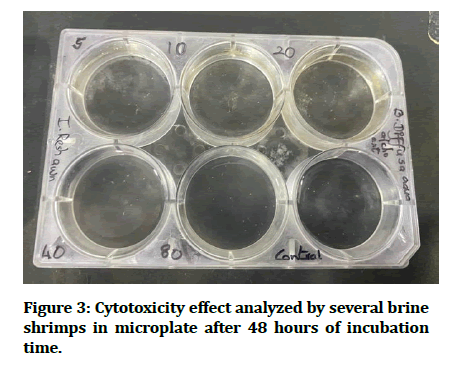
Figure 3:Cytotoxicity effect analyzed by several brine shrimps in microplate after 48 hours of incubation time.
Results
Antioxidant activity
The antioxidant activity of Boerhavia diffusa aqua alcoholic extract was determined by DPPH activity. The activity of the aqua alcoholic extract was compared with standard ascorbic acid by measuring absorption intensity in the spectrophotometer at the wavelength of 517 nm. While increasing the concentration (10 µL, 20 µL, 30 µL, 40 µL, 50 µL) of plant extracts, the percentage of inhibition of DPPH inhibition also increased. However, the inhibition percentage is directly proportional to the concentration of leaf extract as shown in Figures 4-5. Spearman correlation analysis showed positive correlation(r=1) with significant p value of less than 0.05. The absorption intensity with different concentration was tabulated in Table 1.
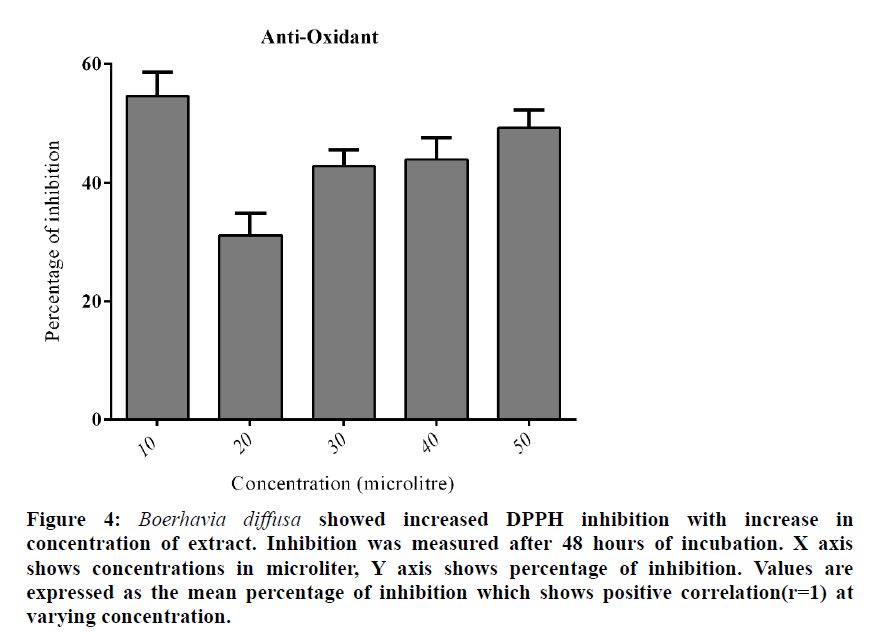
Figure 4:Boerhavia diffusa showed increased DPPH inhibition with increase in concentration of extract. Inhibition was measured after 48 hours of incubation. X axis shows concentrations in microliter, Y axis shows percentage of inhibition. Values are expressed as the mean percentage of inhibition which shows positive correlation(r=1 at varying concentration.
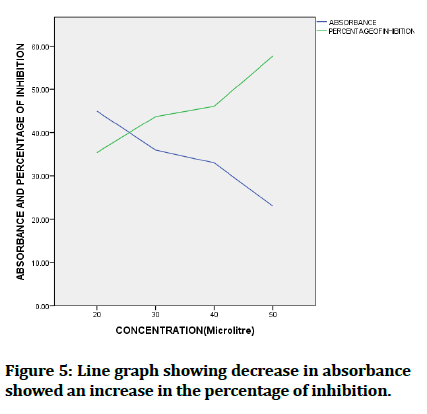
Figure 5:Line graph showing decrease in absorbance showed an increase in the percentage of inhibition.
| Concentration | Wavelength | Absorbance | %t to absorbance formula |
|---|---|---|---|
| 10 | 517 | 0.229 | 35.4 |
| 20 | 517 | 0.22 | 35.4 |
| 30 | 517 | 0.36 | 43.7 |
| 40 | 517 | 0.33 | 46.1 |
| 50 | 517 | 0.45 | 57.7 |
Table 1: The observed values are tabulated with different concentration and corresponding absorbance.
Cytotoxic activity
Brine shrimp lethality assay was performed using the formulated solution. The results obtained from the assay are tabulated and converted into a bar graph as Figure 6 for easy representation. The X-axis represents the concentration of the formulated solution used. The Y-axis represents the number of live nauplii. The graph explains the positive correlation of cytotoxic activity with concentration and the number of live brine shrimps. The formulated solution is given to the nauplii for two days at different concentrations. At 5 μl concentration, all 10 nauplii are alive, at 10 μl of solution 10 nauplii were alive at day 1 and 9 nauplii were alive at day 2. Then the solution is given at 20 μl concentration, 10 nauplii are alive on day 1 whereas 9 nauplii were alive on day 2. At 40 μl concentration, only 8 nauplii were alive on day 2. At 80 μl concentration, only 4 nauplii were alive. In the test control, no extract is added, and though all the nauplii are alive for both the days. On day 2, Decreases in the number of nauplii counts with increase in concentration are represented in Figure 7 and relation between control group and test group are shown in Figure 8. Spearman correlation analysis showed negative correlation(r=-1) with p value<0.05. Results were tabulated with different concentrations of day 1 and day 2 in Table 2.
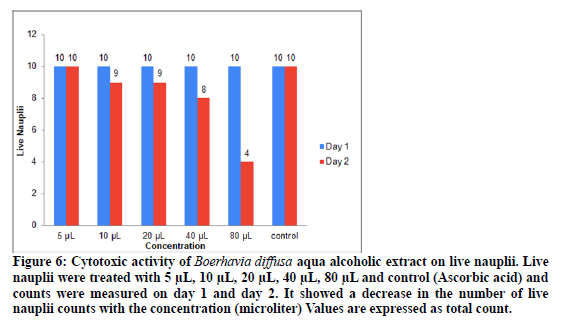
Figure 6:Cytotoxic activity of Boerhavia diffusa aqua alcoholic extract on live nauplii. Live nauplii were treated with 5 µL, 10 µL, 20 µL, 40 µL, 80 µL and control (Ascorbic acid) and counts were measured on day 1 and day 2. It showed a decrease in the number of live nauplii counts with the concentration (microliter) Values are expressed as total count.
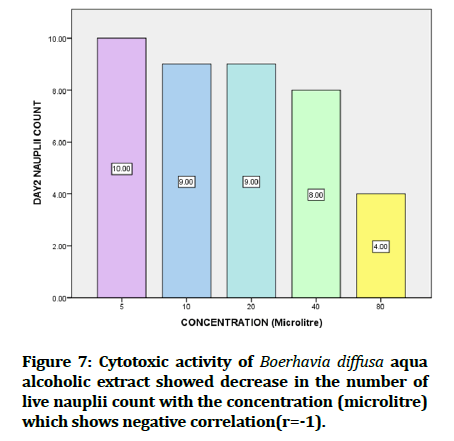
Figure 7:Cytotoxic activity of Boerhavia diffusa aqua alcoholic extract showed decrease in the number of live nauplii count with the concentration (microlitre) which shows negative correlation(r=-1).
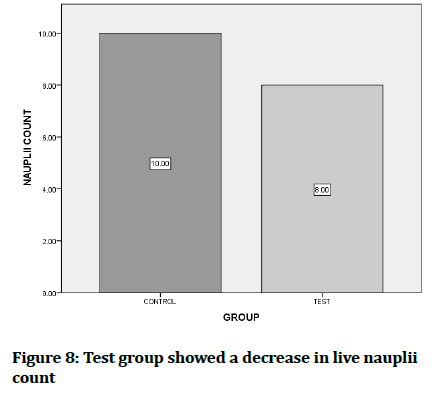
Figure 8:Test group showed a decrease in live nauplii count
| Concentration | 5 µL | 10 µL | 20 µL | 40 µL | 80 µL | Control |
|---|---|---|---|---|---|---|
| Day 1 | 10 | 10 | 10 | 10 | 10 | 10 |
| Day 2 | 10 | 9 | 9 | 8 | 4 | 10 |
Table 2: The number of live nauplii at different concentration of extract after 24hours and 48 hours in relation to the control.
Discussion
Boerhavia diffusa methanol extract antioxidant activity was observed dependent on the scavenging potential of the free radicals (DPPH, NO) due to the presence of flavonoids which are Polyphenolic compounds in methanol extract [38]. The results agree with other researchers’ findings [39] about the antioxidant role of methanol extract B. diffusa has been identified as a result of the presence of rotenoid (boeravinone G, H, and D). Boeravinone G plays a significant role in rotenoids and is also a Polyphenolic agent [40]. Powerful antioxidant activities against free radical DPPH have been demonstrated by various solvent-derived seed extracts. In this study, the increased concentration of all the extracts corresponded to an increase in their antioxidant properties [41]. Previous literature study on antioxidant activity of chitosan nanoparticles and chitosan-lycopene Nano composite solution has increased activity when compared to the standard ascorbic acid, so lycopene mediated chitosan nanoparticles have the potential to be used as an effective antioxidant agent. The synthesis of metal nanoparticles and Nano composites is an emerging area of research and exploration in the field of material science for their unique size and shape [42]. Lycopene with an increase in concentration has increased antioxidant activity but was comparatively less when compared to the standard ascorbic acid. Similarly, silver nanoparticles, graphene oxide nanoparticles and GO-Ag Nano composites were synthesized from seed extracts of amla fruit which showed a good antibacterial effect against oral pathogens with minimal cytotoxicity [43]. Most recently concluded that aqua alcoholic extract of grape-seed proved to be a potent antioxidant and antimicrobial agent and can therefore be used for application in the medical field [44]. A similar study was undertaken to evaluate the antioxidant activity of Ethanol, Chloroform, and Ethyl acetate fraction of Boerhaavia diffusa L roots which might have improved its hepatoprotective action. In Vitro nitric oxide scavenging activity, the percentage inhibition was 71.35%, 33.74%, 23.85% in ethanol, chloroform, and ethyl acetate extracts at 250mcg/ml and this was compared with curcumin at 62 mcg/ml showed only 84.7% inhibition respectively. Extract of chloroform showed a dose-dependent increase and dual-phase response in ethyl acetate and ethanolic extract. In DPPH radical scavenging activity, the ethanol extract showed 81.94% inhibition and the chloroform extract showed 42.58% inhibition at 1000mcg/ml compared with 88.02 % inhibition by Quercetin. The above results suggest that roots of Boerhaavia diffusa were found to reveal antioxidant potential which supports the use of this plant in traditional medicine [45,46] Ethanol extract of Boerhavia diffusa extract inhibits gram-positive bacteria such as S. aureus, B. subtilis, S. faecalis, and M. luteus as well as all gram-negative bacteria used in this study [47]. Except for M. luteus and gram-negative bacteria such as K. pneumoniae, P. vulgaris, S. marcescens, and S. flexneri, methanol extract had an inhibitory effect against all gram-positive bacteria tested. P. aeruginosa had the highest susceptibility in aqueous extract, followed by S. aureus and E. coli had the lowest susceptibility. The antimicrobial activity of the various extracts increased as the concentration was increased. The findings of the research back up local practitioners' ethnomedicinal use of this herb. The findings of this study revealed that both aqueous and ethanolic extracts of B. diffusa had antibacterial activity on E. coli, S. aureus, and P. aeruginosa [48]. Furthermore, studies have shown that the aqueous form of the drug (2 ml/kg) has greater hepatoprotective efficacy than the powder form, which is likely due to the liquid form's stronger absorption through the intestinal tract. The hepatoprotective function of Boerhaavia diffusa L. roots was found to protect serum parameters in rats suffering from thioacetamide toxicity [49]. Another study shows that the aqueous extract of thin roots collected in the summer has a higher operation, indicating that root collection should be done at the right time and with the right form of roots for the best results which also supports the usage of B. diffusa L. roots by many Indian tribes for hepatic ailments [50].
About cytotoxicity, a study stated upon this mitosis of C. jagus roots, a B. diffusa extract had a strong depressive effect. The study used B. diffusa extract, and the control experiment's mitotic index was found to be 5.27. The concentrations of the treatment extracts and the mitotic indices derived from their operation had a negative association. This indicates that this extract inhibits mitosis. The mitotic index was substantially inhibited as the concentration of B. diffusa treatment solution was increased. This time, the concentration of the extract and the mitotic indices provided by the observed behavior have a very negative correlation. Since the root extracts of B. diffusa have the potential to accumulate metaphase and therefore inhibit mitosis, they can be used instead of the more costly colchicine for cytological studies [51]. In the previous study, from the findings (higher LC50 values than 100 µg/mL) of brine shrimp lethality bioassay, it can be concluded that the extracts of B. diffusa do not show any apparent in vitro toxicity compared to positive control which supports the tribes' use of the plant as a non-toxic leafy vegetable. Moreover, the vegetable was found by the researchers as a rich source of some macro and micronutrients [52]. Significant amounts of alkaloids are also non-carcinogenic to the plant [1]. Studies have shown that leaves have nutritional components that can be considered an effective part of the diet, such as vitamin C and calcium.It is therefore quite well assumed that Boerhavia diffusa hydroethanolic extract plays an important role in the scavenging of free radicals and serves as a possible source of natural antioxidants that may be responsible for the existence of secondary metabolites such as phenols, flavonoids, tannin, and alkaloids so Boerhavia diffusa may also act as a potent natural medicine [3].
This study with Boerhavia diffusa aqua extract with the methanolic and ethanolic extract was taken into consideration. Future study has to be elaborated under increased concentration and larger sample size of other species of family Nyctaginaceae. Extract must be tested on various cell lines to check its effectiveness, compatibility and active compounds which exhibit antioxidant properties might be isolated and formulated with other herbal products.
Conclusion
Boerhavia diffusa have cytotoxic and antioxidant properties. The natural plant based nanoparticles with its phytoconstituents in a single pace adds up a huge advantage in eco-friendly nano research.
Acknowledgement
The authors are thankful to Saveetha Institute of Medical and Technical Sciences, Saveetha Dental College and Hospitals, Saveetha University for giving a platform to conduct the study.
Conflict of Interest
The authors would like to declare no conflict of interest in the present study.
Funding
The present project is supported by:
Saveetha Dental College and Hospitals, Saveetha University, Saveetha Institute of Medical and Technical Sciences.
Jahabardeen Agencies, Thanjavur.
References
- Ujowundu CO, Igwe CU, Enemor VH, et al. Nutritive and anti-nutritive properties of Boerhavia diffusa and Commelina nudiflora leaves. Pakistan J Nutr 2008; 7:90-2.
- Chaudhary G, Kaushik N. Phytochemical and pharmacological studies in Pedalium murex L. Phytochem Rev 2017; 16:921-34.
- Gharate M, Kasture V. Evaluation of anti-inflammatory, analgesic, antipyretic and antiulcer activity of Punarnavasava: An ayurvedic formulation of Boerhavia diffusa. Orient Pharm Exp Med 2013; 13:121-6.
- Preethikaa S, Brundha MP. Awareness of diabetes mellitus among general population. Res J Pharm Technol 2018; 11:1825-9.
- Brundha MP. A comparative study-the role of skin and nerve biopsy in hansen's disease. J Pharm Sci Res 2015; 7:837.
- Pan J, Xu J, Luo H, et al. Factors and virological significance of hepatitis B virus pregenomic RNA status after 5 years of antiviral therapy. Int J IInfect Dis 2021; 105:418-23.
- Akah PA, Nwambie AI, Gamaniel KS, et al. Experimental study of the anticonvulsant plants used for treatment of infantile convulsion in Nigeria. Brain Res Bulletin 1997; 44:611-3.
- Waiganjo B, Moriasi G, Onyancha J, et al. Antiplasmodial and cytotoxic activities of extracts of selected medicinal plants used to treat malaria in Embu county, Kenya. J Parasitol Res 2020; 2020.
- Pari L, Amarnath Satheesh M. Antidiabetic effect of Boerhavia diffusa: Effect on serum and tissue lipids in experimental diabetes. J Med Food 2004; 7:472-6.
- Govindarajan R, Vijayakumar M, Pushpangadan P. Antioxidant approach to disease management and the role of ‘Rasayana’herbs of Ayurveda. J Ethnopharmacol 2005; 99:165-78.
- Harsha L, Brundha MP. Prevalence of dental developmental anomalies among men and women and its psychological effect in a given population. J Pharm Sci Res 2017; 9:869.
- Manu KA, Kuttan G. Anti-metastatic potential of Punarnavine, an alkaloid from Boerhaavia diffusa Linn. Immunobiol 2009; 214:245-55.
- Srivastava AN, Misra JS, Srivastava S, et al. Cervical cancer screening in rural India: Status & current concepts. Indian J Med Rese 2018; 148:687.
- Timothy CN, Samyuktha PS, Brundha MP. Dental pulp stem cells in regenerative medicineâ??A literature review. Res J Pharm Technol 2019; 12:4052-6.
- Kabir Y. Functional foods in cancer prevention and therapy. Academic Press 2020; 508.
- Nimisha P. Evaluation of insecticidal activity of Boerhavia diffusa against certain stored product insects. Int J Adv Res 2019; 7:1252â??5.
- Rao AV, Agarwal S. Role of antioxidant lycopene in cancer and heart disease. J Am College Nutr 2000; 19:563-9.
- Anita R, Paramasivam A, Priyadharsini JV, et al. The m6A readers YTHDF1 and YTHDF3 aberrations associated with metastasis and predict poor prognosis in breast cancer patients. Am J Cancer Res 2020; 10:2546.
- Jayaseelan VP, Paramasivam A. Emerging role of NET inhibitors in cardiovascular diseases. Hypertens Res 2020; 43:1459-61.
- Sivakumar S, Girija AS, Priyadharsini JV. Evaluation of the inhibitory effect of caffeic acid and gallic acid on tetR and tetM efflux pumps mediating tetracycline resistance in Streptococcus sp., using computational approach. J King Saud University Sci 2020; 32:904-9.
- Smiline Girija AS. Delineating the Immuno-dominant antigenic vaccine peptides against gacs-sensor kinase in Acinetobacter baumannii: An in silico investigational approach. Frontiers Microbiol 2020; 11:2078.
- Jaisankar AI, Girija AS, Gunasekaran S, et al. Molecular characterisation of csgA gene among ESBL strains of A. baumannii and targeting with essential oil compounds from Azadirachta indica. J King Saud University Sci 2020; 32:3380-7.
- AS SG. Fox3+ CD25+ CD4+ T regulatory cells (Tregs) may transform the n-CoV's final destiny to CNS!. J Med Virol 2021; 93:5673-5675.
- Jayaseelan VP, Ramesh A, Arumugam P. Breast cancer and DDT: putative interactions, associated gene alterations, and molecular pathways. Environ Sci Pollution Res 2021; 28:27162-73.
- Arumugam P, George R, Jayaseelan VP. Aberrations of m6A regulators are associated with tumorigenesis and metastasis in head and neck squamous cell carcinoma. Arch Oral Biol 2021; 122:105030.
- Kumar SP, Girija AS, Priyadharsini JV. Targeting NM23-H1-mediated Inhibition of tumour metastasis in viral hepatitis with bioactive compounds from ganoderma lucidum: A computational study. Indian J Pharm Sci 2020; 82:300-5.
- Girija SA, Priyadharsini JV, Paramasivam A. Prevalence of carbapenem-hydrolyzing OXA-type Ã?-lactamases among Acinetobacter baumannii in patients with severe urinary tract infection. Acta Microbiol Immunol Hungarica 2020; 67:49-55.
- https://www.futuremedicine.com/doi/abs/10.2217/epi-2021-0001
- Mathivadani V, Smiline AS, Priyadharsini JV. Targeting epstein-barr virus nuclear antigen 1 (EBNA-1) with Murraya koengii bio-compounds: An in-silico approach. Acta Virol 2020; 64:93-9.
- Girija AS S, Priyadharsini J V. Prevalence of Acb and non-Acb complex in elderly population with urinary tract infection (UTI). Acta Clinica Belgica 2021; 76:106-12.
- Anchana SR, Girija SA, Gunasekaran S,et al. Detection of csgA gene in carbapenem-resistant Acinetobacter baumannii strains and targeting with Ocimum sanctum biocompounds. Iranian J Basic Med Sci 2021; 24:690.
- Girija AS, Shoba G, Priyadharsini JV. Accessing the T-Cell and B-Cell immuno-dominant peptides from A. baumannii biofilm associated protein (bap) as vaccine candidates: A computational approach. Int J Peptide Res Therapeut 2021; 27:37-45.
- Arvind P, Jain RK. Skeletally anchored forsus fatigue resistant device for correction of class II malocclusionsâ??A systematic review and meta-analysis. Orthod Craniofac Res 2021; 24:52-61.
- Venugopal A, Vaid N, Bowman SJ. Outstanding, yet redundant? After all, you may be another Choluteca Bridge!. In Seminars Orthod 2021; 27:53-56.
- Ramadurai N, Gurunathan D, Samuel AV, et al. Effectiveness of 2% Articaine as an anesthetic agent in children: Randomized controlled trial. Clin Oral Investigat 2019; 23:3543-50.
- Varghese SS, Ramesh A, Veeraiyan DN. Blended module-based teaching in biostatistics and research methodology: A retrospective study with postgraduate dental students. J Dent Educ 2019; 83:445-50.
- Mathew MG, Samuel SR, Soni AJ,et al. Evaluation of adhesion of Streptococcus mutans, plaque accumulation on zirconia and stainless steel crowns, and surrounding gingival inflammation in primary molars: Randomized controlled trial. Clin Oral Investig 2020; 24:3275-80.
- Wagner HK, Wolff PM. New natural products and plant drugs with pharmacological, biological or therapeutical activity: Proceedings of the first international congress on medicinal plant research, section a, held at the University of Munich, Germany, Springer Science & Business Media 2012.
- Aviello G, Canadanovic-Brunet JM, Milic N, et al. Potent antioxidant and genoprotective effects of boeravinone G, a rotenoid isolated from Boerhaavia diffusa. PLoS One 2011; 6:e19628.
- Taher M, Susanti D, Rezali MF, et al. Apoptosis, antimicrobial and antioxidant activities of phytochemicals from Garcinia malaccensis Hk.f. Asian Pac J Trop Med 2012; 5:136â??41.
- Rajeshkumar S, Lakshmi T, Tharani M, et al. Green synthesis of gold nanoparticles using pomegranate peel extract and its antioxidant and anticancer activity against liver cancer cell line. Alinteri J Agric Sci 2020; 35:164â??9.
- Begum A, Jeevitha M, Preetha S, et al. Cytotoxicity of iron nanoparticles synthesized using dried ginger. J Pharm Res Int 2020; 112â??8.
- Soundarajan S, Malaippan S, Rajeshkumar S. Antibacterial activity and cytotoxicity of amla seed mediated graphene oxide, silver nanoparticle & Go-Ag nanoparticle-AN in vitro study. Plant Cell Biotechnol Mol Biol 2020; 55â??67.
- Kandhan TS, Rajasekar A, Rajeshkumar S. Grape seed aqua alcoholic extract preparation and its antioxidant, antimicrobial and cytotoxic effect-An in vitro study. Plant Cell Biotechnol Mol Biol 2020; 18â??26.
- Martiwar P. Evaluation of cytotoxic activity of andrographis echioides nees. World J Pharm Res 2017; 1011â??26.
- Sreeja S, Sreeja S. An in vitro study on antiproliferative and antiestrogenic effects of Boerhaavia diffusa L. extracts. J Ethnopharmacol 2009; 26:221â??5.
- Hudson JB. The Echinacea herb story: Tradition meets modern science. Friesen Press 2016; 168.
- Apu AS, Liza MS, Jamaluddin ATM, et al. Phytochemical screening and in vitro bioactivities of the extracts of aerial part of Boerhavia diffusa Linn. Asian Pac J Trop Biomed 2012; 2:673â??8.
- Olaleye MT, Akinmoladun AC, Ogunboye AA,et al. Antioxidant activity and hepatoprotective property of leaf extracts of Boerhaavia diffusa Linn against acetaminophen-induced liver damage in rats. Food Chem Toxicol 2010; 48:2200-5.
- Pullaiah T, Ramaiah M. Handbook of research on herbal liver protection: Hepatoprotective plants. CRC Press 2021.
- Nwakanma NM, Okoli BE. Cytological effects of the root extracts of Boerhaavia diffusa on root tips of Crinum jagus. Eur Asian Journal of BioSci 2010; 4:105-11.
- Butkhup L, Samappito S. In vitro free radical scavenging and antimicrobial activity of some selected Thai medicinal plants. Res J Med Plant 2011; 5:254-65.
Indexed at, Google Scholar, CrossRef
Indexed at, Google Scholar, CrossRef
Indexed at, Google Scholar, CrossRef
Indexed at, Google Scholar, CrossRef
Indexed at, Google Scholar, CrossRef
Indexed at, Google Scholar, CrossRef
Indexed at, Google Scholar, CrossRef
Indexed at, Google Scholar, CrossRef
Indexed at, Google Scholar, CrossRef        Â
Indexed at, Google Scholar , CrossRef          Â
Indexed at, Google Scholar, CrossRef
Indexed at, Google Scholar, CrossRef
Indexed at, Google Scholar, CrossRef
Indexed at, Google Scholar, CrossRef
Indexed at, Google Scholar, CrossRef Â
Indexed at, Google Scholar, CrossRef
Indexed at, Google Scholar, CrossRef
Indexed at, Google Scholar, CrossRef
Indexed at, Google Scholar, CrossRef
Indexed at, Google Scholar, CrossRef
Indexed at, Google Scholar, CrossRef
Indexed at, Google Scholar, CrossRef
Indexed at, Google Scholar, CrossRef
Indexed at, Google Scholar, CrossRef
Indexed at, Google Scholar, CrossRef
Author Info
Naz Fathima Raj Mohamed1, Priyadharshini R1*, S Rajesh Kumar2 and Palati Sinduja1
1Department of Pathology, Saveetha Dental College, Saveetha Institute of Medical and Technical Sciences (SIMATS), Chennai, India2Department of Pharmacology, Saveetha Dental College, Saveetha Institute of Medical and Technical Sciences, Chennai, India
Citation: Naz Fathima Raj Mohamed, Priyadharshini R, S Rajesh Kumar, Palati Sinduja, In vitro Bioactivities of Aqua Alcoholic Extracts of Plant Boerhavia Diffusa Linn., J Res Med Dent Sci, 2022, 10(1): 143-150
Received: 14-Dec-2021, Manuscript No. JRMDS-21-44652; , Pre QC No. JRMDS-21-44652 (PQ); Editor assigned: 16-Dec-2021, Pre QC No. JRMDS-21-44652 (PQ); Reviewed: 30-Dec-2021, QC No. JRMDS-21-44652; Revised: 04-Jan-2022, Manuscript No. JRMDS-22-44652 (R); Published: 11-Jan-2022
